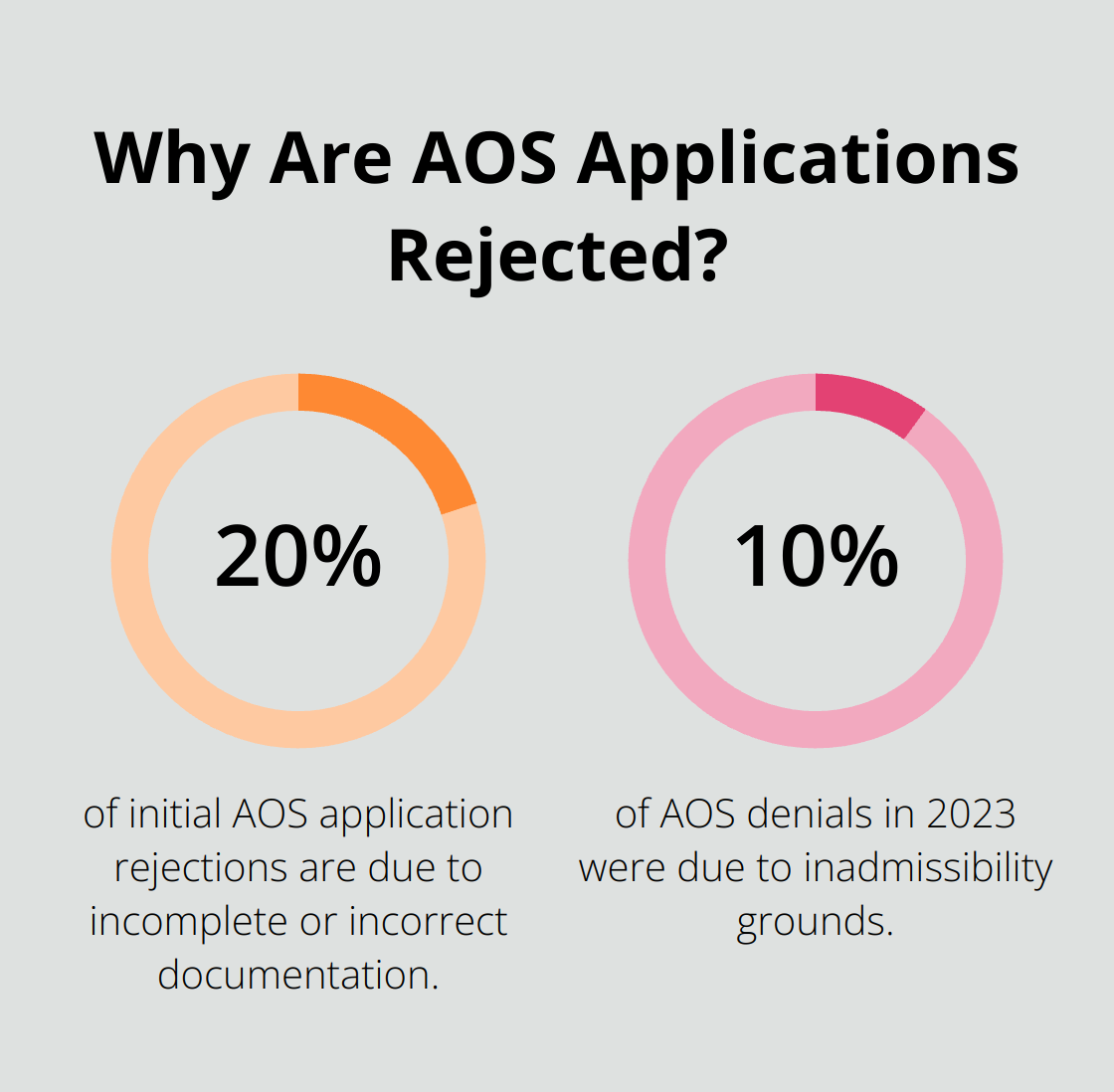
Adjustment of Status Requirements: Are You Eligible?
Navigating the path to permanent residency in the United States can be complex. Adjustment of Status (AOS) offers a way for eligible individuals to change their immigration status without leaving the country.
At Law Offices of Jeffrey A. Thompson, we often guide clients through the intricate Adjustment of Status requirements. Understanding these criteria is crucial for determining your eligibility and increasing your chances of a successful application.
What Is Adjustment of Status?
Definition and Process
Adjustment of Status (AOS) allows eligible individuals to apply for lawful permanent resident status if they are in the United States. The U.S. Citizenship and Immigration Services (USCIS) oversees this process for those who meet specific criteria and are already present in the U.S.
AOS vs. Consular Processing
AOS and consular processing differ significantly in their execution:
- AOS: The entire process occurs within the U.S.
- Consular Processing: Applicants attend interviews at U.S. embassies or consulates in their home countries.

This distinction proves vital for individuals who cannot or prefer not to leave the U.S. during their application process.
Benefits of Choosing AOS
Opting for Adjustment of Status offers several advantages:
- Applicants remain in the U.S. throughout the process
- Maintenance of current jobs and family ties
- Potential eligibility for work authorization and travel permits during pending cases
These benefits provide more flexibility and stability for applicants.
Key Eligibility Factors
Not all individuals qualify for AOS. Primary requirements include:
- Legal entry into the U.S.
- Maintenance of valid immigration status
- An approved immigrant petition
Common Misconceptions
Many applicants misunderstand AOS eligibility. For example, some mistakenly believe a pending asylum application qualifies them for AOS, only to discover they’re ineligible due to specific entry requirements. Such misunderstandings emphasize the importance of professional guidance in navigating the complex AOS landscape.
As we move forward, we’ll explore the specific eligibility requirements for Adjustment of Status in greater detail, providing you with a comprehensive understanding of this critical immigration process.
Who Qualifies for Adjustment of Status?
Adjustment of Status (AOS) offers a path to permanent residency, but not everyone qualifies for AOS. Let’s examine the key requirements you must fulfill to pursue AOS successfully.
Lawful Entry and Status Maintenance
To qualify for AOS, you must have entered the United States legally. This typically means you arrived with a valid visa or underwent inspection and admission at a port of entry. USCIS data shows that in fiscal year 2023, over 90% of approved AOS applications came from individuals who entered the country lawfully.

Maintaining lawful status holds equal importance. This means you haven’t overstayed your visa or violated its terms. However, exceptions exist. For example, immediate relatives of U.S. citizens may still qualify for AOS even if they’ve fallen out of status.
Family or Employment Connections
You need a qualifying relationship or job offer to be eligible for AOS. Family-based categories include immediate relatives of U.S. citizens and certain preference categories for other family members. Employment-based categories range from priority workers to skilled and unskilled laborers.
In 2023, family-based adjustments constituted approximately 65% of all AOS approvals, while employment-based adjustments made up about 30%.
Visa Number Availability
For many categories, a visa number must be immediately available when you file for AOS. The Department of State’s Visa Bulletin (updated monthly) determines this availability. Wait times can vary significantly based on your category and country of origin.
As of February 2025, F2B category applicants (unmarried sons and daughters of permanent residents) from Mexico face a wait time of over 22 years, while the same category for most other countries has a wait time of about 7 years.
Admissibility to the United States
You must be admissible to the U.S. This means you don’t have any grounds of inadmissibility, such as health issues, criminal activity, national security concerns, public charge, lack of labor certification (if required), or fraud. If you do have potential grounds of inadmissibility, you may need to file for a waiver.
Understanding these requirements forms the foundation of a successful AOS application. However, the process involves numerous complexities and potential challenges. In the next section, we’ll explore common obstacles applicants face and strategies to overcome them.
Navigating AOS Hurdles
Status Gaps and Unauthorized Work
Adjustment of Status (AOS) applicants often face issues with gaps in their legal status or periods of unauthorized employment. If you file your TPS re-registration application late, processing may be delayed and can lead to gaps in your work authorization. However, exceptions exist, particularly for immediate relatives of U.S. citizens.

If you have fallen out of status, document the reasons why. For example, if a previous employer failed to file necessary paperwork, gather evidence to support your case. For unauthorized work, check if you qualify for any forgiveness provisions (such as those available to certain VAWA applicants).
Criminal History and Immigration Violations
Even minor criminal offenses can impact your AOS application. A recent study found that administrative arrests in FY 2023 increased, driven by arrests of noncitizens with criminal convictions or pending criminal charges.
If you have a criminal record, obtain certified court dispositions for all arrests and convictions. Prepare to explain the circumstances and demonstrate rehabilitation. For immigration violations (like overstaying a visa), explore potential waivers or exceptions with an experienced attorney.
Documentation Challenges
The AOS process requires extensive documentation. USCIS reports that incomplete or incorrect documentation accounts for nearly 20% of initial application rejections. To avoid this, create a comprehensive checklist of required documents well in advance.
Key documents often include birth certificates, marriage certificates, divorce decrees, and employment verification letters. Ensure all foreign language documents receive proper translation. If certain documents are unavailable, prepare to explain why and provide alternative evidence.
Attention to detail is important. A single missing or incorrectly filled form can lead to significant delays or even denial of your application.
Grounds of Inadmissibility
Certain factors can make an applicant inadmissible, potentially derailing the AOS process. These range from health-related issues to prior immigration fraud. According to USCIS, about 10% of AOS denials in 2023 stemmed from inadmissibility grounds.
If you face potential inadmissibility, don’t lose hope. Many grounds of inadmissibility have corresponding waivers. For example, if you’re inadmissible due to unlawful presence, you might qualify for a waiver if you can demonstrate extreme hardship to a qualifying U.S. citizen or permanent resident relative.
Professional Guidance
Navigating these challenges requires a thorough understanding of immigration law and current USCIS policies. While this overview provides a starting point, each case presents its own set of hurdles. Professional legal guidance can prove invaluable in identifying potential issues early and developing strategies to overcome them.
The Law Offices of Jeffrey A. Thompson in Brockton, Massachusetts, specializes in immigration law and can provide expert assistance in navigating the complexities of the AOS process. With their dedicated approach, they help clients overcome legal hurdles and achieve their immigration goals.
Final Thoughts
The Adjustment of Status process demands a comprehensive understanding of eligibility criteria and potential obstacles. Applicants must meet specific adjustment of status requirements, including lawful entry, valid status maintenance, and admissibility. These factors form the core of a successful application, but the intricacies involved can present challenges for many individuals.

Professional legal guidance often proves essential in navigating this complex process. Immigration laws and policies undergo frequent changes, making it difficult for applicants to stay informed. An experienced immigration attorney can provide current advice, identify potential issues, and develop strategies tailored to each unique case.
Law Offices of Jeffrey A. Thompson specializes in guiding clients through the Adjustment of Status process. Our team understands the nuances of immigration law and stays current with USCIS policies. We assist clients in preparing comprehensive applications and addressing potential grounds of inadmissibility (from family-based petitions to employment-related adjustments).


